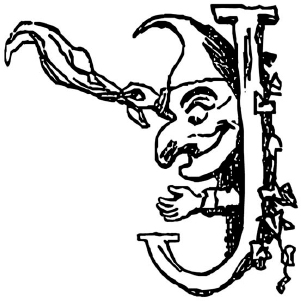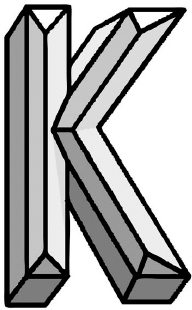Alphabetical (21 page)
Authors: Michael Rosen


â¢
IN CONTINENTAL EUROPE
, the old Latin âi' sound was also being pronounced in a variety of other ways, the main three being: hard âj', soft âj' (âzh') and the back-of-the-throat âch' sound that is used in Spanish. In the 1500s when printing started to standardize spelling, the letter âj' began to be used. The Spanish were first off as early as the 1470s; French printers adopted it about a hundred years later. In Britain, where speakers retained the Old Norman pronunciation of initial âi' as âj', the letter âj' appeared consistently in print from about 1640.
âJ' is the Johnny-come-lately of the alphabet. Indeed, Samuel Johnson, as late as 1755, regarded âJ' as some kind of lower order of letter, referring to it as a variant of âI'. In the 1950s, in my grammar school, where doodling was an important way to pass the time when lessons got tedious, there was much silent debate (secret passing of notes) as to whether the upper-case âJ' should have a âhat' on or not.
The shape of the letter derives from scribes putting fancy tails on their âI's as early as AD 400. The Carolingian scribes of Charlemagne adopted the tail for their upper-case âI' so by the time the Spanish printers were looking around for a symbol to represent their âch' to distinguish it from the âi' in the middle of words, the old decorated âi' was waiting for them.
j
The lower-case âj' seems to have first appeared in the work of French printers in the early 1600s, who adopted the dot as part of its familial relationship to âi'.
PRONUNCIATION OF THE LETTER-NAME
At the outset, âJ' maintained its bloodline to âI' and was pronounced âJye' to rhyme with âI'. This poses a small mystery: most of the changes in letter-names are a consequence of the late medieval Great Vowel Shift, but the letter âJ' was created in England after the vowel shift. Perhaps âjye' and âjay' were both in usage and reciters of the alphabet preferred to rhyme âj' with the letter after it, rather than the letter before it.
PRONUNCIATION OF THE LETTER
Thanks to the Normans, this is a consistent consonant in English â âjam jar', âjetski', âjilt', âjoust' and âJanuary' â nearly always appearing as a first letter. We don't usually combine it with other letters, though one of the spellings of âgenie' used to be âdjinn' and you can spell Norwegian sea-inlets as âfjord' rather than âfiord'. The most common sighting of a âj' on the end of words is in the word and name âRaj' and I wouldn't have got through university if it wasn't for regular visits to âThe Taj'. We do have other ways of making the âj' sound â as in âgorge' and âbridge' â but these haven't as yet evolved into âgorj' or âbrij'. I confess there are times when I've texted words like âfrij'.
The words âjelly', âgel' and âjello' mean nearly the same things but not quite. âJo-jo' and âJ. J.' crop up a lot and âJ.' or âJay' are going through a popular phase for singers' names.
The word âjudge' with its two âj' sounds has a weighty air about it, so when we say someone is acting as âjudge and jury' we can sound even heavier.
T
HESE ARE FOR
sharing. It's disastrous to put any kind of commentary on jokes, but I'll make the observation that the alphabet is a source for humour because it is a seemingly obvious bit of knowledge. Alphabetical jokes are really different ways of pointing out that there is an aspect of this that you hadn't thought of. For children, there is an extra twist in that the alphabet remains mysterious until it is so embedded that they've forgotten about it. To release these hidden meanings is comedy magic â like conjuring. Talking of which, how do you turn a rabbi into a furry animal? Give him tea.
The most alphabetical kind of a joke is the âletter rebus' where some way of saying letters will give you a word or part of a word.
You could write, âAre you ready?' as âRUE?' (that is, if the âE' were coloured red).
2Ys UR, 2Ys UB, ICUR 2Ys 4ME
is: âToo wise you are, too wise you be, I see you are too wise for me,' though purists write it: âYYUR YYUB ICUR YY4ME.'
You can also write things to add up like arithmetic:
UR
2Â Â GOOD
2Â Â ME
2Â Â BE
4Â Â
GOT
10
Or: âYou are too good to me to be forgotten.'
Try this in a South African accent:
F.U.N.E.X.? (âHave you any eggs?')
S.I.F.X. (âYes, I have eggs.')
F.U.N.E.M.? (âHave you any ham?')
S.I.F.M. (âYes, I have ham.')
I.L.F.M.N.X. (âI'll have ham and eggs.')
A comment on our common biology:
   Â
IP
   Â
UP
   Â
we all P,
   Â
don't we?
People use these letter rebuses as a kind of abbreviation. In the film industry people will write âsound effects' as âsound FX' and there are shops in Essex and on the Essex Road called âSX stores'). Marcel Duchamp's moustached
Mona Lisa
of 1919 has the title: âL.H.O.O.Q.' Sound that out (in French) and it sounds like âelle a chaud au cul', meaning âshe has a hot bum', or, in animal terms, âshe is on heat'.
Which US state is this? EEEEEEEEEEC. (âTennessee'.)
LOV
is âendless love'.
N N N N N N N
A A A A A A A
C C C C C C C
is â7-up cans'.
R. P. I.
would be a grave error.
UAMAAME
âYou amaze me.'
NOPPPLEE
No peas please.
BAYBGGUS
Baby Jesus.
UFOFOL
âYou effin' fool' (or â“f” is in the word “fool”').
I met Tiger Woods once and said,
âIn your line of work,
UUUAT, don't you?'
And he said, âYes.'
(âYou use a tee.')
These circulate in the playground:
Which 3 letters of the alphabet make everything in the world move?
NRG.
   Â
Old Mother Hubbard
   Â
Went to the cupboard
   Â
To fetch her poor dog a bone
   Â
When she got there
   Â
The cupboard was bare
   Â
so she said:
   Â
O-I-C-U-R-M-T
Which two letters are always jealous?
N-V.
What begins with T, ends with T, and is filled with T?
A teapot.
I'm only close friends with twenty-five letters of the alphabet because I hate U.
Why has the alphabet got only twenty-five letters at Christmas?
[sing] No-el, no-el, no-el, no-e-e-el . . .
Teacher: Millie, give me a sentence starting with âI'.
Millie: I is . . .
Teacher: No, Millie . . . Always say, âI am.'
Millie: All right . . . âI am the ninth letter of the alphabet.'
What do you call a deer with no eyes?
No idea.
What do you call a dead deer with no eyes?
Still no idea.
If you leave alphabet soup on the stove and go out, it could spell disaster.
Why can't pirates learn the alphabet?
They get lost at C.
I can never remember how to get to the end of the alphabet.
I don't know Y.
But I can say the alphabet backwards.
Go on then.
T, E, B, A, H, P, L, A, E, H, T.
But my favourite alphabetical joke of all is a joke alphabet. The cockney alphabet has to be said aloud to get the jokes but it's a good grounding in how to sound like an East Ender of old. There are many versions but these are my favourites, which I offer you now â explanations in brackets.
A for 'orses (hay for horses)
B for mutton (beef or mutton)
C for miles (see for miles)
D for ential (deferential)
E for brick (heave a brick)
F for vessence (effervescence)
G for police (chief o' police)
H for consent (age for consent)
I for lootin' (highfalluting)
J for orange (Jaffa orange)
K for teria (cafeteria)
L for leather (hell for leather)
M for sis (emphasis)
N for a penny in for a pound (in for a penny etc)
O for the wings of a dove
P for relief
Q for a song (cue for a song)
R for mo (half a mo)
S for Williams (Esther Williams â pre-war Hollywood star)
T for 2 (âTea for Two')
U for mism (euphemism)
V for la France (Vive la France)
W for a quid (double you for a quid)
X for breakfast (eggs for breakfast)
Y for mistress (wife or mistress)
Z for 'is 'at. (his head for his hat)

⢠âK'
STARTS OUT
life as an Egyptian hieroglyph in around 2000
BCE
. It looks like an outstretched hand, as seen from the side, with only one finger visible and the thumb laid on top. The ancient Semites took the notion of the hand, showed the palm (minus the thumb) and called it âkaph', meaning âpalm of the hand' and signifying the sound âk'. It's a wide âU' with two unattached strokes within the frame of the âU'. This sign appears on inscriptions dating from around 1750
BCE
.
The Phoenicians turned this into a three-stroke sign, three lines converging on an apex at the base. This was around in 1000
BCE
. Two hundred years later, it has rotated to look like the reverse of our âK' with the downstroke as a diagonal. The ancient Greeks took this as their âkappa', with the downstroke now in a vertical position, and when their writing moved to be consistently left to right, âkappa' flipped to resemble our âk'. The classic Roman inscriptions added the serifs and the thin-thick strokes.
k
The small âk' derives directly from Charlemagne's scribes in âCarolingian minuscule' in the ninth century and the typographers of the 1500s picked that up for their lower case. The key difference between lower- and upper-case formations of the letter are that the lower case's upper diagonal stroke doesn't reach the height of the top of the vertical stroke.